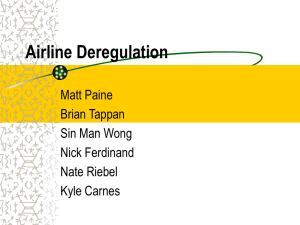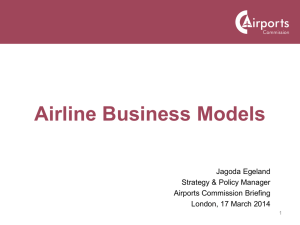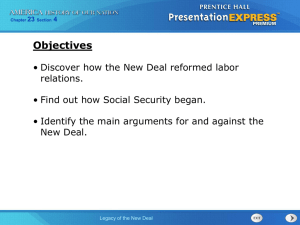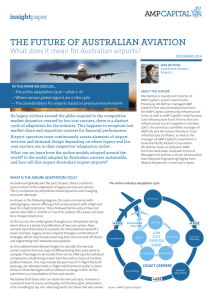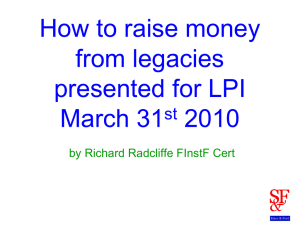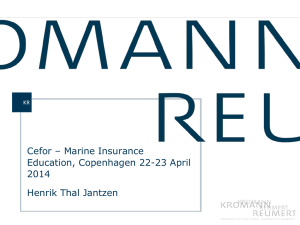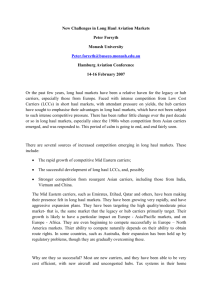Okun*s Law, Productivity Innovations, and Conundrums in Business
advertisement
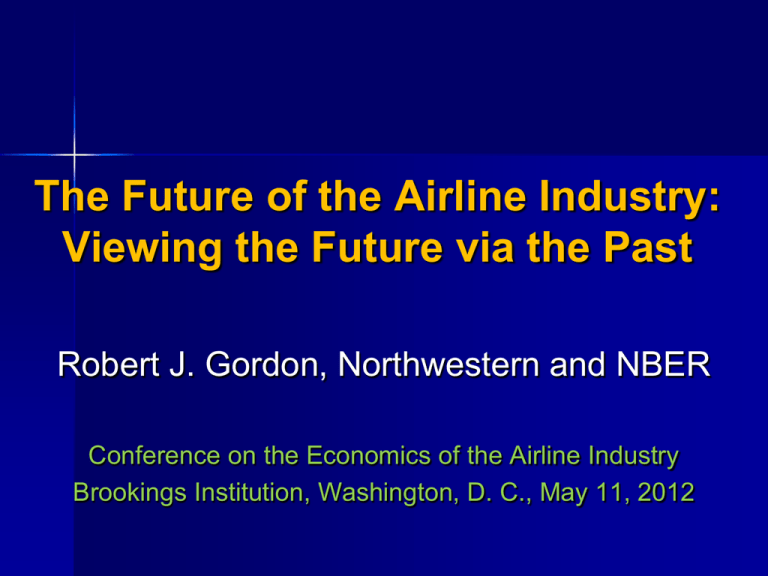
The Future of the Airline Industry: Viewing the Future via the Past Robert J. Gordon, Northwestern and NBER Conference on the Economics of the Airline Industry Brookings Institution, Washington, D. C., May 11, 2012 The Best Clue to the Future is the Past. To project out into the future 20 years, it helps to look back in 20-year chunks (U. S. oriented chronology) – 1952 to 1972 Technology, the transition to jets under a regulated regime – 1972 to 1992 Deregulation and the first round of mergers – 1992 to 2012 Alliances, further mergers, the squeeze on union rents, and multiple bankruptcies The Future for the U. S. Industry The U. S. – owned legacy network carriers have hit a wall – Income elasticity of air travel has fallen to 1.0 – Price elasticity translates higher oil prices into lower traffic – No improvement in aircraft technology except for fuel efficiency – Main effects of the electronic revolution have already occurred This contrasts with the traditional regime in which innovations drove down real fares which increased traffic growth and yielded scale economies The World ex-US The income elasticity is higher but still falling Technology involves not only fuel efficiency but also longer range Future favors the Asian carriers European legacy carriers: squeezed by super LCCs in Europe, Mideast carriers long-haul, fuel emissions charges, and airport constraints Geography protects North American carriers from Emirates (Etihad, Qatar) US: Nominal Airline Revenue as a Percent of Nominal GDP US: RPM Divided by Real GDP US: Nominal and Real Yield The U. S. Transition from a Dynamic to a Stagnant Industry Nominal revenue / nominal GDP at a plateau since 1978 RPMs / real GDP at a plateau since 1988 Annual relative price decline in logs: 1952-72 = -2.4% 1972-92 = -1.2% 1992-2011 = -0.1% From a Luxury Good to an Everyday Good Regression of RPMs on real GDP and relative price (all in changes) Income elasticity 1949-72 = 2.65 1972-90 = 1.73 1990-2011 = 1.05 Price elasticity = -0.58 Compared to -0.56 in Berry-Jia AEJ Micro 2010, data for 2006, average of leisure and business travel demand To Make Matters Worse, Real GDP Growth Is Slowing Down U. S. growth in real per-capita GDP 1929-2007 = 2.2 % per year In 2007 I wrote a paper forecasting a slowdown to 1.4 % per year 2007-27 As of 2012:Q1 we are now 8.1 percent below that historically unprecedented slow growth path. And GDP growth is slowing relative to GDP per capita, due to merciless hounding and deportation of illegal immigrants The Domestic Industry Has Reached Technological Stasis 1952-72, the technological revolution In 1952 NYC-LAX required a connection at MDW or DAL. 12 hours westbound 1953, nonstop DC-7s, the “AA Mercury” 1959, nonstop 707s. 707 delivered 20x net revenue compared to the DC-7 for about 3x the purchase price. A technological revolution. Conversion to short-haul jets complete by 1971 (727, 72S, 737-200, DC-9-20/30/50) A Reminder About Technological Stasis DL still flies the DC-9-50, manufactured in the mid 1970s and thus roughly 35+ years old. – My pilot friend’s report: there are 21 D95’s left. – Passengers on the D95 don’t know that they are not on a MD-90. Now-retired D93 (1968) same. – Fuel economy improvement from D95 to 73G (current generation) is 15 percent. Conclusion: consumer welfare has not improved since 1968 for narrowbodies. RJs? Good: replace props, new nonstop routes, no center seats. Bad: waiting for that roll-aboard. In an All-jet world, How the Industry Changed 1972-92 Deregulation: Pricing – Pricing rationalized. Previously long-haul overcapacity (piano bars) with paucity of short-haul frequency and service Deregulation: Network Effects – Mythology that point-to-point nonstop service was replaced by connections – Few nonstop routes between major cities were discontinued. 422 of top 500 markets had nonstop service in both 1978 and 1989 – All residents of new hub cities benefitted from proliferation of new nonstops – Interline connections fell by a factor of 10, from 40 percent to 4 percent FF Benefits: Made possible by deregulation plus advances in computers The Role of Unions Legacy labor costs make it inevitable that legacy firms must shrink Low-cost competitors (Toyota vs. GM), (Wal-Mart vs. Sears) grow faster, thus have younger employees. Older firms have more unions, higher wages, lower productivity, as well as legacy pension and retiree medical care costs. The Big-3 auto recovery and the legacy airlines UAW agreed to two-tier wage systems Outsourcing to RJs allows airlines a two-tier system Consolidation to “Big Three” network legacies accelerates the decline of unions (would any president allow strike?) Union Rents and Their Consequences During most of the postwar era there has been a long line of applicants desiring to become airline pilots The applicants are willing to work for far less than the incumbent flight crews Thus the incumbents earn a rent that distorts markets Airline strikes were frequent before 1990 – Disruption, mutual aid pacts – Helped to cause liquidation of EA under Borman – Actions in last decade rule out a strike as an option for the major network carriers Why Pilot Union Rents are Different In a competitive labor market salaries would have been far different Long-hauls easy, fewer duties, lower pay Short-hauls more work, more duties, higher pay Bankruptcy laws allowed airlines to escape union contracts, but couldn’t save EA, PA, TW High point of union arrogance the UA ESOP 1994-2000 when Rick Dubinsky promised to “wring the neck of the golden goose”. The golden goose turned to a lead weight The Biggest Changes during 1992-2012? Aircraft downsized from domestic widebodies. New outsourcing to RJs owned by other non-union suppliers Electronics and the web – Airline web sites bring purchase in-house and reduce GDS fees – Increased ease of comparing fares put further downward pressure on legacy fares – Electronics Lobby e-kiosks eliminate most waiting in line (except for TSA) Lots of gate screen information for standby passengers The Next 20 Years: the U.S. Continued evolution of consumer-friendly web apps. Eventually weather and maintenance-related delays may lead carriers to implement automatic rebookings. A basic impediment to consumer-friendly proactive rebookings: high fees to change tickets for most passengers Three legacy carriers (AA+US, DL, UA) will continue trying to beat down their legacy costs Qualifications: WN’s costs are rising faster than legacies as WN becomes a quasi-legacy. Competition from lowcost Air Tran is eliminated by merger Continued price competition from B6, Allegiant, Spirit Safe prediction: the relative price of air travel will increase, no longer decreasing. Cozy and lazy trio. The Next 20 Years: Aircraft Size Artificial gaps now due to union scope clauses Classic example AA: few planes between 50 and 140 seats The next 20 years will even this out Liberalized scope clauses Legacies buying 90-120 seat planes to be flown by union pilots at reduced wages Scheduling efficiency by having a continuum of aircraft sizes World Ex US: Nominal Revenue as a Percent of Nominal GDP World Ex US: RPM Divided by Real GDP World Ex US: Nominal and Real Yield Asia is the Future Companies are newer, fewer legacy costs Costs are lower because of dense routes, use of wide-bodies on relatively short routes In some countries airline passengers per year per member of the population are still 1/10 of U. S. and Western Europe implying lots of potential for future growth China’s protection of its Big 3 airlines and suppression of LCC’s How will Asian and U. S. airlines share future growth in Transpacific traffic? When will the U. S. finally eliminate tedious visa delays and procedures for Asian tourists? Most Threatened Now: EU Legacy Network Airlines Reasons why the big European legacy firms are in big trouble. Will they eventually disappear? (BA, AF/KL, LH, AZ, IB, SK) The power of unions, the social welfare state, and the difficulty of voiding union contracts through bankruptcy The competition of Ryanair, Easyjet, and the new lowcost carriers on their money-losing intra-Europe routes Traditional markets Europe-Asia are becoming dominated by the big three Middle East carriers (EK, EY, QR). But don’t bet on EK quite yet; it may finally have ordered too many planes. DXB-RNO in a 380? Reasons U. S. Legacy Airlines Face a Smaller Threat The brutal battles of bankruptcy are largely over, whereas European carriers have barely begun facing legacy union costs Geography makes the Middle East carriers largely irrelevant – While DXB is a perfect connection spot for Europe to India and Australia, it is irrelevant for US-Europe, and US-Asia (BOS-PEK +3000 miles), and US-Australia (JFK-SYD +4000 miles). Exception: India (SFO-BLR +400 miles) May wipe out not only future nonstops US-India but aloso future existence of India-based carriers US LCCs (WN, B6) are more mature than Ryanair and EasyJet. Costs of WN and B6 are inexorably creeping up relative to the network legacies. How Will EU Legacies Adjust? LH has just announced cancellation of 7 long-haul routes to secondary Asian destinations Other LH problems – high taxes, EU emissions trading, night flying ban at FRA. It claims $900 million per year BA faces permanent constraint of two runways at LHR Incentive to move aircraft to NA and SA routes – But with revenue sharing under JV’s, benefits would be shared with U. S. alliance partners How will the EU legacies survive? – Wages have to fall, productivity has to rise – A future of strikes, slowdowns? – Will governments let one of them fail? Conclusion: Stasis inside the U. S., Drama Outside
